Wednesday 28 September 2011
The Charming and Social Degu
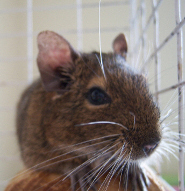
The degu (
Octodon degus) is a small mammal belonging to the rodent family, and is most closely related to the guinea pig and chinchilla. Degus are sometimes referred to as brush-tailed rats, and originate from the grasslands of
Chile. They average at about 25 to 30 centimeters (9.8–12.2 inches) in length and weigh 170 to 300 grams (6-11 ounces). The degu has small ears, powerful hind legs and a long tail similar to a rat's tail except furry. The degu's genus name, Octodon, comes from the appearance of its front teeth, which are in the shape of a figure 8.
Degus are strict herbivores, and in the wild their diet consists largely of dried grasses, shrubs and the occasional seed. One interesting fact about the degu's diet is that these animals seem to be highly susceptible to diabetes due to their natural diet consisting of very low amounts of sugar. For this reason, degus have become popular in the medical research field.
Degus are highly social creatures, and in the wild they live together as large families in burrows. They are communal diggers, and organize coordinated digging projects. Through teamwork, degus create vast circuits of tunnels and nests that couldn't be made by one individual degu. Even the female degus will sometimes nest and nurse their pups communally. Degus tend to forage for food in groups as well, in order to increase the chance of detecting nearby predators. They communicate primarily by sound, and can produce up to 15 unique sounds. Degus are diurnal, meaning they sleep during the peak daylight and nighttime hours and awaken during dusk and dawn, when it is harder for predators to find them as they forage for food.
Because of their popularity in diabetes research, degus were imported from Chile during the 1950s, and it was found that they make charming pets. While not mainstream pets yet, they are slowly becoming more popular. Degus are quite easily tamed, and remain active, playful and extremely social in captivity. They are very inquisitive and like to chew, however, so a large metal cage with plenty of running and climbing room is a must. Also, degu owners must make sure to provide their pets with other degu companions, since they are such social animals. They must also make sure to provide the right type of low-sugar diet. Degus will even bathe themselves in dust like chinchillas do.
Picture of the degu by Jessica Skinner (
Daintiest at en.wikipedia), licensed under
Creative Commons Attribution 3.0 Unported license.
You can help spreading the word about this animal by liking it on facebook
Permanent Link
Tuesday 27 September 2011
Northern Saw-Whet Owl - Cute Trickster
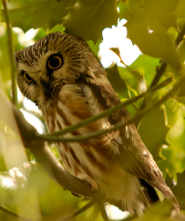
The Northern Saw-Whet Owl (
Aegolius Acadicus), is a member of the Strigidae classification of owls from the 26 genera known as typical owls. This distinction is divided down to four Aegolius species commonly called 'small forest owls'. The Northern Saw-Whet is one of the smallest owls. They have a short, stocky build with a relatively short tail. The average Saw-Whet measures 7 - 8.5 or 18 - 22cm in length. Their weight ranges from 2.6 - 4.6 ounces or 75 - 130 grams. Wingspan of these forest owls are 17-21 inches or 23-53 cm.
Acadicus indicates where the owls were originally sighted. European explorers came across them in a North America location called Acadia which is now Nova Scotia. The name Saw-Whet was coined because of the unique sound these owls emit. They are an attractive bird with fluffy plumage of brownish red streaked with white and spotted underneath. Their flight feathers are spotted with white. The owls have a rather large head and unlike other owls, no ear tufts.
Northern Saw-Whet owls live and nest in dense forest areas. They prefer coniferous trees but will roost in heavy shrubs. They often build their nests in places where woodpeckers, like the Pileated and
Northern Flicker, have hollowed out a hole. They prefer to nest alongside creeks and streams. Saw-Whet owls are carnivorous, existing mostly on small mammals, frogs and insects. They also kill and eat birds like sparrows, chickadees or even larger cardinals and doves. The Saw-Whet has a curious habit of 'freezing' their left-overs. Rarely do they eat an entire carcass but tear it in half and store the remaining meal inside the nest.
In breeding the male picks out the nest and lures the female with song, dance and a mouse in its bill. They breed from March through July, typical nest is five to six eggs. The male provides food during the broody season, about 21 days, but the female keeps the nest tidy. When the nestling are about 18 days old she finds a new home but helps feed the young owls for several weeks.
Northern Saw-Whet owls are not on an endangered list. Their predators are larger owls,
Cooper's Hawks and similar raptors. Life expectancy is from five to eight years.
The Northern Saw-Whet owls are also tricksters. If found by humans they sit very still trying to impress them with their tameness and cuteness, when in fact they can be quite vicious.
Picture of the Northern Saw-Whet Owl by
brendan.lally, licensed under the
Creative Commons Attribution 2.0 Generic license.
You can help spreading the word about this animal by liking it on facebook
Permanent Link
Friday 23 September 2011
Pygmy Slow Loris - Toxic but Cute
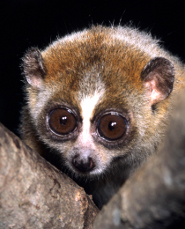
The Pygmy slow loris (
Nycticebus pygmaeus) is a rare, large-eyed nocturnal primate. Although, they primarily live in the tropical forests of
Vietnam,
Laos,
Cambodia and
China, they can also been found in Vietnam's bamboo thickets and Laos's evergreen forests. The Pygmy slow loris almost became extinct in Vietnam after much of its habitat was destroyed by war. Today, deforestation is still a major threat to this species, and it is currently listed as vulnerable on the International Union for Conservation of Nature's Red List.
The Pygmy slow loris is a very small
primate, growing to only approximately 15 to 25 centimeters (roughly 6 to 10 inches) in length. It typically weighs on average 400 grams or 14 ounces. The loris has a stubby tail, light brown to deep reddish brown fur, white markings on its face, as well as a gray or white underside. This primate also has large, forward facing eyes that help it to see at night.
Lorises are nocturnal omnivores. They enjoy dining on a wide selection of food, including floral nectar, tree gum or sap, plants, fruits, small mammals and insects. These creatures have strong hands and feet that allow them to grip branches very tightly. When a loris spots prey, it will grip a branch tightly with its hind legs and then lunge forward to grab it. It will also use the element of surprise, allowing unsuspecting prey to approach it before launching an attack. The Pygmy slow loris can rarely be found on the ground, preferring the comfort and safety of the trees. Predators of the Pygmy slow loris include pythons, orangutans and hawk eagles.
The Pygmy slow loris is a mostly solitary creature. They typically only come together during their mating season, although they have occasionally been found sleeping together in small groups. When asleep, the loris will curl up in a tight ball, while still clinging to a branch.
Though lorises are cute, resembling tiny teddy bears, they are one of the few mammals capable of producing a toxin. When frightened, these small primates have been known to lick the area under their arms where the toxin is produced, so that if it bites something, the poison will get into the wound. Though the toxin is not known to be fatal to humans, it may cause painful swelling. In addition, one woman who was bitten was reported to have gone into anaphylactic shock.
Picture of the pygmy slow loris by David Haring / Duke Lemur Center, licensed under
Creative Commons Attribution-Share Alike 3.0 Unported license.
You can help spreading the word about this animal by liking it on facebook
Permanent Link
Wednesday 21 September 2011
The Japanese Sawshark -- the Samurai of the Ocean
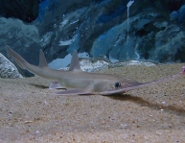
The
Japanese sawshark (
Pristiophorus japonicus) is one of the ocean's more bizarre-looking creatures. It has a flat snout, studded with teeth, which resembles a serrated saw. Protruding from the middle of the saw-like snout are two long, sensitive, whisker-like barbels. The sawshark uses these barbels, along with electro-receptors located on the underside of its saw -- which are known as ampullae of Lorenzini -- to help it find prey buried in the sand as it cruises along the bottom of the ocean. The Japanese sawfish typically feeds on fish, squid, shrimp and other crustaceans. Once it locates its prey, the Japanese sawfish will first use its snout to uncover its prey from the sand and then kill or maim it with savage slashes of its saw-like snout.
The Japanese sawshark is not a big shark and typically does not grow larger than one-and-half meters or six feet in length. It is sometimes mistaken for a similar looking creature known as the sawfish, which actually belongs to the ray family. Sawfish do not have barbels and the teeth located on its snout are all evenly sized, whereas the teeth of a sawshark alternate from big to little to big. In addition, the sawshark has gills on the side of its head, while the gills of a sawfish are located on its underside.
The Japanese sawshark is ovoviviparous, which means that its babies, known as pups, develop in eggs while inside the mother's body. The gestation period for a sawshark is typically 12 months and an average litter size is ten pups. It is believed that a Japanese sawshark can live up to 15 years in the wild.
This shark's main predator are humans, and its flesh is especially popular in Japan, where it often used as an ingredient in a fish cake known as kamaboko. Currently, the Japanese sawshark, which can be found in ocean waters near
Taiwan, northern
China,
Japan,
South Korea and
North Korea, is not considered to be an endangered or threatened species.
Other members of the sawshark or Pristiophorus family include the Bahamas sawshark, the sixgill sawshark, the longnose and shortnose sawshark.
Picture of the sawshark by
opencage.info, licensed under
the Creative Commons Attribution-Share Alike 2.5 Generic license.
You can help spreading the word about this animal by liking it on facebook
Permanent Link
Monday 19 September 2011
The Scarlet Macaw - the Rainforest's Living Jewel
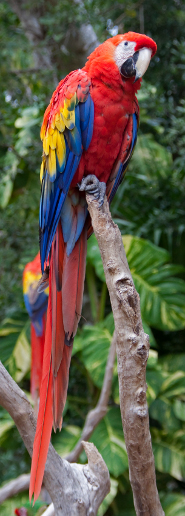
The Scarlet Macaw (
Ara Macao) is an endangered parrot species known for the brilliant feathers it displays. Found in undisturbed rain forests from the southern end of
Mexico down into South America all the way to northern
Argentina, the magnificent birds prefer low-lying country, never found above 1,000 meters (3280 feet) elevation.
The Scarlet Macaw is an endangered species, partly because their habitat is becoming deforested, and their attractive feathers make them a target for poachers. Macaws are caught in the wild for sale as pets and to harvest the feathers, and although this is illegal, it is still a common practice in some locations. In
Costa Rica, where the Scarlet Macaws disappeared from the wild, an extensive reintroduction program is underway. Some breeders raise Scarlet Macaws, making a market of legal parrots available to fanciers.
In the wild, the Scarlet Macaw lives in the highest canopy of the rainforest, eating mostly fruits and nuts. They eat clay, a peculiarity which may assist with digestion. During breeding season, with higher activity levels, they will add insects to their diet for more protein. Once they are mated, the pair of Macaws will settle into a tree cavity and lay two to three eggs. Once hatched, the young will not leave the nest for three months, and may stay with their parents for up to two years. Due to this slow maturation, Scarlet Macaws reproduce less prolifically than other parrot species.
Due to the large size of the Scarlet Macaw, 80-90 cm long (31-36 inches), more than half of which is tail, it is immediately visible even in the perpetual gloom of the rainforest. It has few predators as an adult, although a
jaguar or eagle may take on occasion. The vulnerable young in the nest may be lost to marauding snakes or monkeys. At full growth, the Macaw will only weigh about 1 kg (2.2 lb) as most of its apparent bulk is feathers.
Picture of the scarlet macaw by Tony Hisgett, licensed under the
Creative Commons Attribution 2.0 Generic license.
You can help spreading the word about this animal by liking it on facebook
Permanent Link
Thursday 15 September 2011
The Lion-Tailed Macaque - A Crying Old Man
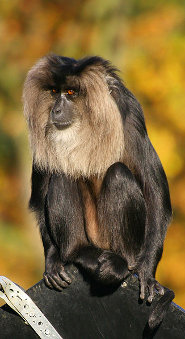
The liontail macaque (
Macaca silenus) is known to German speakers as the “Beard Ape.” This nomenclature, describes the silver-colored mane that encircles the lion-tailed macaque’s face. Aside from this mane, the rest of its appearance is dark. The hair is either a very dark brown or black, and the face is black. Thus, the beard resembles the grey beard of an old man with dark hair.
The lion-tailed macaque measures from 45 to 60 cm. (17 to 24 in.) and has a tail of around 25 cm. (10 in.). Their weight is between 3 and 10 kg. (7 to 22 lbs.). At zoos, these macaques can reach ages upwards of 30 years old, but in their natural habitat the life expectancy of a lion-tailed macaque is shortened to 20 years.
Living along the western coast of India, these monkeys are naturally found in Karnataka, Kerala and Tamil Nadu. Researchers believe that approximately 30,000 to 35,000 lion-tailed macaques can be found in this region. Due to this small population and the small geographical area they are found in, these primates are classified as endangered.
The endangered classification of lion-tailed macaques has been a tenuous issue over the past few decades. From 1977 to 1980, India’s main environmental debate was over the region of these monkeys. Thankfully, they have survived, mostly because of a strong public effort to save them. A little over a decade later, in the mid-1990s, fourteen troops of lion-tailed macaques were observed in the valley that was so fiercely fought over earlier. In the surrounding areas, several smaller, but self-sustaining, groups have been discovered.
The lion-tailed macaque enjoys the rain forests of this area of
India. Although they prefer to eat the plants, invertebrates, insects and small vertebrates native to this part of India, the lion-tailed macaque can adapt to a wide variety of food sources.
When predators invade the territory, the lion-tailed macaque first screams loudly. If this does not succeed, then the macaques bawl equally as emotionally. In these situations, the lion-tailed macaque looks like a little old man, who lost a toy, crying loudly.
You can help spreading the word about this animal by liking it on facebook
Permanent Link
Tuesday 13 September 2011
The Desert Hedgehog - Four Legged Sandbur
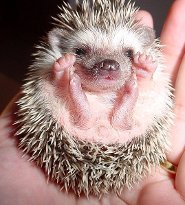
The desert hedgehog (
Hemiechinus aethiopicus) is the smallest member of the hedgehog family and, like its name implies, lives in arid desert regions. It is widespread and can be found throughout parts of Africa and the Middle East, including the Sahara,
Morocco,
Egypt,
Sudan,
Ethiopia,
Syria,
Israel,
Jordan and
Iraq. The desert hedgehog is a highly adaptable little creature and because of this, it has continued to thrive and maintain a stable population despite encroaching human habitation in some areas.
The desert hedgehog is particularly small, averaging only 16-29 centimeters in length and weighing from 310-435 grams, with males typically larger sizes than females. In appearance, the desert hedgehog matches its environment fairly well; the back spikes are often banded dark with paler tips while the forehead and underfur is mainly white or gray. Feet, tail and snout are all dark to sandy brown.
Despite its small size, this hedgehog has a protective layer of spines that form a formidable barrier against hawks, jackals, large snakes and predatory lizards that might otherwise make a meal of it. When threatened, the muscles along the hedgehog's skin contract to form a tight ball of spikes that protect it against attack.
The desert hedgehog itself is omnivorous, feeding mainly on insects, small snakes and lizards, spiders, eggs and fruit. Though it can survive in very arid regions, it prefers to make its home in an oasis, garden or where plant and animal life is more abundant than what is typically found in the open desert. Desert hedgehogs are usually a welcome sight in any groves or home gardens, as they help to keep pest insects under control. It is a nocturnal creature, doing most of its foraging at night and resting in what shade may be available during the hottest parts of the day.
Interestingly enough, the desert hedgehog hibernates for short periods during the coolest winter months, January and February, before emerging during the spring breeding season in March. Gestation is usually about 40 days, and females give birth to litters ranging between two to six young.
Picture of the desert hedgehog by Max Korostischeveski, licensed under the
Creative Commons Attribution-Share Alike 3.0 Unported license.
You can help spreading the word about this animal by liking it on facebook
Permanent Link
Monday 12 September 2011
Northern Pudu - the World's Smallest Deer
The Northern Pudu (
Pudu mephistophiles) is the world's smallest deer. This little inhabitant of the Andes Mountains weighs in at only 3 to 6 kg, or 7 to 13 pounds. The Northern Pudu lives and plays across
Columbia,
Ecuador, and
Peru. They prefer to stay in the higher elevations of the Andes Mountain range. Most of them live at least 2000 meters above sea level. The climate here is a temperate rainforest, with a wet winter and arid summer.
What Do They Look Like?
These little deer have a stocky body and slim legs. They average 32 - 35 cm, or 13 - 14 inches tall. They are approximately 85 cm or 33 inches long. They are slightly larger than a small house dog or a large cat. They have a Southern branch of the family that lives in Chili and Argentina. This species is slightly larger. Their fur is thick, stiff and lays close to the body. They range in color from a reddish brown to a darker brown. The males sport backward curving antlers that do not split.
How Do They Survive?
The Pudu is a solitary animal interacting socially only to mate. They are nocturnal by nature and thrive on leaves, shrubs, sprouts, blossoms and bark. They do not eat meat. They are adept at climbing, jumping and sprinting which helps them evade predators. They tend to move slowly and purposefully through the lush climate, utilizing dense vegetation to hide. Predators include owls, foxes, and large wild cats.
How Many Young Do They Have?
Mating season is short, lasting from April to May each year. Once done they return to their solitary existence. The female Pudu carries her young six to seven months. Most mothers have only one baby, but twins do occur with some regularity. Pudu young will stay with their Mommas for between 8 - 12 months before heading out on their own. Most of them have an average lifespan of 8 - 10 years.
Why Are They Endangered?
The Pudu is listed as vulnerable on the ICUN red list. The main causes of death are disease, loss of habitat, and over hunting. The Pudu is prone to become infected with various types of worms such as the round worm and heart worms. The worms multiply rapidly overcoming their small bodies. Loss of habitat has lead to a decline in mating and death from road accidents. Adding to the problem are hunters. The Pudu is eagerly sought due to the skill needed to track and kill them. Conservationist are working to restore and preserve the habitat for these precious little deer.
You can help spreading the word about this animal by liking it on facebook
Permanent Link
Monday 12 September 2011
South American Squirrel Monkey - Tiny Bandits
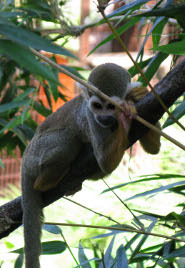
The South American squirrel monkey (
Saimiri sciureus) is a small breed of primate native to both South and Central America, particularly countries such as Peru, Venezuela, Colombia, Bolivia and Brazil.
The height between the sexes is usually in the same range, from 269 to 318mm (10.6 to 12.52 in). Weight usually differs by gender, with males weighing from .649 to 1.25 kg (1.43 to 2.76lbs) and females weighing .649 to .898 kg. (1.43 to 1.98lbs) This weight can fluctuate because squirrel monkeys put on weight in the two months leading up to breeding season in order to appear larger and appear more favorable for selection. They also have the ability to store water and fat between muscle and skin on their upper bodies.
The species is often found in lowland tropical rainforest, but can survive in numerous different habitats. Their diets consist of fruits and insects, ranging from grasshoppers and caterpillars to nectar and flower buds. They also can consume small birds, bird eggs, and tent-making bats that hang in trees. They prefer small, berry-like fruits. Feeding grounds are often protected and monopolized by groups or clusters, leading to some fighting between them. They also often are found feeding and traveling alongside
capuchin monkeys.
The squirrel monkey's newborn are preyed upon by a diverse group of predators, including birds of prey such as the
double-toothed kite, and also are preyed on by
tayras,
spider monkeys, coatis, possums, snakes and cats.
These squirrel monkeys, once endangered, were moved up to the "vulnerable" classification in 2008, due to conservation efforts that improved the population numbers of the species. The decline was and is attributed to prevalence of hunting, deforestation of their habitats, and capture to be kept as small pets.
South American squirrel monkeys are most commonly known for their playful, empathetic nature -- and their habit of stealing common objects and food from humans, sometimes right out of the hands of passersby! Their main form of movement is through the treetops, and they are quadripedal, meaning they use all four limbs to get around.
You can help spreading the word about this animal by liking it on facebook
Permanent Link
Tuesday 06 September 2011
Starry Flounder - Master of disquise
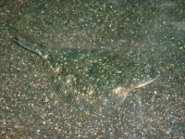
The flounder (
Platichthys stellatus), also known as the starry flounder, can be found around the edges of the North Pacific Ocean. Nicknamed the 'righteye flounder', the fish can actually have its eyes set on either side of its head, the right being more common. Very difficult to spot as they blend in with the ocean floor, once you do spot them, they're easy to recognize; the flounder is the only fish that both lays and swims horizontally!
Young flounders are born like other fish, swimming 'normally' or vertically; the dorsal side up and the ventral side down. As they mature, they begin to tip to one side and spend the rest of their lives horizontally. The eye that was on the side of the body that began to tip down migrates to the 'top' side of the fish. Interestingly, the side of the body that faces the ground also loses its dark color.
Starry flounders are black to dark brown in color with a distinctive whitish orange stripe on the anal and dorsal fins. Their scales are star shaped tupercles which gives the flounder its rough, scratchy feel. The fish has a white belly which makes them difficult for predators to see when they are underneath the fish looking up. The longest starry flounder was recorded at 91 cm (35.8 in) and the heaviest weighed in at 9 kg (19.8 lb).
The starry flounder lives in the Pacific, as far as
Japan and Korea, along the coasts of Alaska and
Canada and along the west coast of the
United States. The fish prefers shallow waters and can often be found in estuaries and into the freshwater zone. Some starry flounder forego the shallow inshore waters for the deep waters of the ocean, having been found as deep as 375 m (1230.14 ft).
The flounder feeds on crabs, worms, clams and other small fish. In turn,
humans capture the flounder, as they do other common flatfish, in large numbers for food and ornamental purposes. Because the flounder can tolerate varying levels of salinity they can live in a wide range of habitat. This protects the fish from becoming endangered as humans fish for them in large numbers.
You can help spreading the word about this animal by liking it on facebook
Permanent Link
 The degu (Octodon degus) is a small mammal belonging to the rodent family, and is most closely related to the guinea pig and chinchilla. Degus are sometimes referred to as brush-tailed rats, and originate from the grasslands of Chile. They average at about 25 to 30 centimeters (9.8–12.2 inches) in length and weigh 170 to 300 grams (6-11 ounces). The degu has small ears, powerful hind legs and a long tail similar to a rat's tail except furry. The degu's genus name, Octodon, comes from the appearance of its front teeth, which are in the shape of a figure 8.
The degu (Octodon degus) is a small mammal belonging to the rodent family, and is most closely related to the guinea pig and chinchilla. Degus are sometimes referred to as brush-tailed rats, and originate from the grasslands of Chile. They average at about 25 to 30 centimeters (9.8–12.2 inches) in length and weigh 170 to 300 grams (6-11 ounces). The degu has small ears, powerful hind legs and a long tail similar to a rat's tail except furry. The degu's genus name, Octodon, comes from the appearance of its front teeth, which are in the shape of a figure 8.
 The Northern Saw-Whet Owl (Aegolius Acadicus), is a member of the Strigidae classification of owls from the 26 genera known as typical owls. This distinction is divided down to four Aegolius species commonly called 'small forest owls'. The Northern Saw-Whet is one of the smallest owls. They have a short, stocky build with a relatively short tail. The average Saw-Whet measures 7 - 8.5 or 18 - 22cm in length. Their weight ranges from 2.6 - 4.6 ounces or 75 - 130 grams. Wingspan of these forest owls are 17-21 inches or 23-53 cm.
The Northern Saw-Whet Owl (Aegolius Acadicus), is a member of the Strigidae classification of owls from the 26 genera known as typical owls. This distinction is divided down to four Aegolius species commonly called 'small forest owls'. The Northern Saw-Whet is one of the smallest owls. They have a short, stocky build with a relatively short tail. The average Saw-Whet measures 7 - 8.5 or 18 - 22cm in length. Their weight ranges from 2.6 - 4.6 ounces or 75 - 130 grams. Wingspan of these forest owls are 17-21 inches or 23-53 cm.  The Pygmy slow loris (Nycticebus pygmaeus) is a rare, large-eyed nocturnal primate. Although, they primarily live in the tropical forests of
The Pygmy slow loris (Nycticebus pygmaeus) is a rare, large-eyed nocturnal primate. Although, they primarily live in the tropical forests of  The Japanese sawshark (Pristiophorus japonicus) is one of the ocean's more bizarre-looking creatures. It has a flat snout, studded with teeth, which resembles a serrated saw. Protruding from the middle of the saw-like snout are two long, sensitive, whisker-like barbels. The sawshark uses these barbels, along with electro-receptors located on the underside of its saw -- which are known as ampullae of Lorenzini -- to help it find prey buried in the sand as it cruises along the bottom of the ocean. The Japanese sawfish typically feeds on fish, squid, shrimp and other crustaceans. Once it locates its prey, the Japanese sawfish will first use its snout to uncover its prey from the sand and then kill or maim it with savage slashes of its saw-like snout.
The Japanese sawshark (Pristiophorus japonicus) is one of the ocean's more bizarre-looking creatures. It has a flat snout, studded with teeth, which resembles a serrated saw. Protruding from the middle of the saw-like snout are two long, sensitive, whisker-like barbels. The sawshark uses these barbels, along with electro-receptors located on the underside of its saw -- which are known as ampullae of Lorenzini -- to help it find prey buried in the sand as it cruises along the bottom of the ocean. The Japanese sawfish typically feeds on fish, squid, shrimp and other crustaceans. Once it locates its prey, the Japanese sawfish will first use its snout to uncover its prey from the sand and then kill or maim it with savage slashes of its saw-like snout. The Scarlet Macaw (Ara Macao) is an endangered parrot species known for the brilliant feathers it displays. Found in undisturbed rain forests from the southern end of
The Scarlet Macaw (Ara Macao) is an endangered parrot species known for the brilliant feathers it displays. Found in undisturbed rain forests from the southern end of  The liontail macaque (Macaca silenus) is known to German speakers as the “Beard Ape.” This nomenclature, describes the silver-colored mane that encircles the lion-tailed macaque’s face. Aside from this mane, the rest of its appearance is dark. The hair is either a very dark brown or black, and the face is black. Thus, the beard resembles the grey beard of an old man with dark hair.
The liontail macaque (Macaca silenus) is known to German speakers as the “Beard Ape.” This nomenclature, describes the silver-colored mane that encircles the lion-tailed macaque’s face. Aside from this mane, the rest of its appearance is dark. The hair is either a very dark brown or black, and the face is black. Thus, the beard resembles the grey beard of an old man with dark hair. The desert hedgehog (Hemiechinus aethiopicus) is the smallest member of the hedgehog family and, like its name implies, lives in arid desert regions. It is widespread and can be found throughout parts of Africa and the Middle East, including the Sahara,
The desert hedgehog (Hemiechinus aethiopicus) is the smallest member of the hedgehog family and, like its name implies, lives in arid desert regions. It is widespread and can be found throughout parts of Africa and the Middle East, including the Sahara,  The South American squirrel monkey (Saimiri sciureus) is a small breed of primate native to both South and Central America, particularly countries such as Peru, Venezuela, Colombia, Bolivia and Brazil.
The South American squirrel monkey (Saimiri sciureus) is a small breed of primate native to both South and Central America, particularly countries such as Peru, Venezuela, Colombia, Bolivia and Brazil.  The flounder (Platichthys stellatus), also known as the starry flounder, can be found around the edges of the North Pacific Ocean. Nicknamed the 'righteye flounder', the fish can actually have its eyes set on either side of its head, the right being more common. Very difficult to spot as they blend in with the ocean floor, once you do spot them, they're easy to recognize; the flounder is the only fish that both lays and swims horizontally!
The flounder (Platichthys stellatus), also known as the starry flounder, can be found around the edges of the North Pacific Ocean. Nicknamed the 'righteye flounder', the fish can actually have its eyes set on either side of its head, the right being more common. Very difficult to spot as they blend in with the ocean floor, once you do spot them, they're easy to recognize; the flounder is the only fish that both lays and swims horizontally!